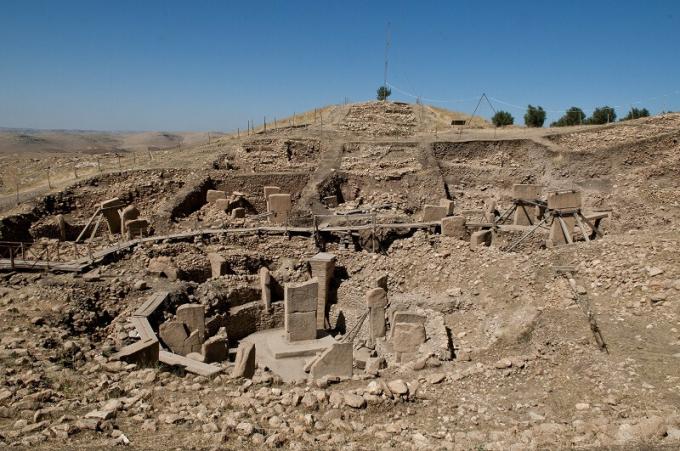Göbekli Tepe: origins and characteristics of this prehistoric monument
The complex has the honor of being considered the first sanctuary in the world, but what is the truth in this statement? Its antiquity is far from doubt: the megaliths of Göbekli Tepe have been dated to the X millennium BC. c.
Specifically, it was erected in a period between 9,600 and 8,200 BC. C., which makes it 6,000 years older than the Stonehenge megalithic complex in Great Britain. Six millennia is indeed a long time. Who raised Göbekli Tepe? What was its function? Why was it built on a rocky surface?
- Related article: "The 6 stages of Prehistory"
The origin of Göbekli Tepe
The myth of the first sanctuary was already supported by Klaus Schmidt, the archaeologist who carried out the first excavations in the place. Schmidt claimed that Göbekli Tepe represented "the world's first temple," and attributed its construction to a group of nomadic hunter-gatherers., based on the abrupt morphology of the land, which made any agricultural or livestock activity impossible.
But if the authors of Göbekli Tepe were nomads, why did they build such a complex? Neolithic nomadic groups were itinerants, who moved depending on food or weather. Why, then, invest effort and time in the construction of a complex, which they would possibly end up abandoning?
Schmidt's theory, then, runs into important pitfalls. A possible explanation would be that, indeed, the authors of the complex were human groups settled, dedicated to agriculture, and that the error comes from the substantial change produced in the land. Thus, according to some authors, Göbekli Tepe would have been, in the Neolithic, a fertile land.
- You may be interested in: "Archaeology: what is it and what does this discipline study"
A more than obvious antiquity
Leaving aside what specific function it fulfilled, what is clear is that Göbekli Tepe is a complex that is more than 12,000 years old, which makes it the oldest site in the world.

It is not at all coincidental that it is located in Turkey, located in the so-called Fertile Crescent, a large area that extends from the Turkish coast to present-day Iran and Iraq and which saw the birth and crystallize a multitude of prosperous civilizations, such as the Sumerian, the Babylonian, the Hittite or the Persian. The first human settlements have been found in this area; specifically, in Mesopotamia (the valley between the Tigris and Euphrates rivers), where it is assumed, based on the available deposits, that agriculture was born.
What is considered the oldest village, Çatal Hüyük, is also located in present-day Turkey. Its oldest strata date from the VIII millennium BC. C., so they would place it in a stage prior to the first Sumerian populations in the Euphrates valley. Çatal Hüyük could be considered, then, one of the oldest testimonies of stable human settlement. However, let us remember that the Göbekli Tepe megalithic complex dates from the 10th millennium BC. C, that is, no less than 2,000 years before Çatal Hüyük, which renews the questions about it.
- Related article: "The 8 branches of the Humanities (and what each of them studies)"
A large megalithic complex
Technically, the megalithic culture began in Europe around the fourth millennium BC. c. This culture, common to many of the peoples settled in the western part of Europe, the Mediterranean area and North Africa, was based on the use of large stone monoliths, enormous blocks with which the typical constructions of this culture were configured: the cromlech, the dolmen and the tumulus. stonehenge, in England, is one of the best examples of this type of construction.
But we have already commented that Göbekli Tepe is much older. Can we call it, then, megalithic culture? Let's see what this deposit consists of and we can, in this way, draw better conclusions.
In stratum III, which is the oldest, monolithic pillars and rough stone walls have been found. In stratum II, which corresponds to the VIII millennium BC. c. (this would be, therefore, contemporary to Çatal Hüyuk) remains of rooms were found, of quite refined construction for the time. Finally, evident remains of agricultural activity were found in the most recent strata, which reinforces the idea that the creators of Göbekli Tepe were already farmers and herders (at least, the last inhabitants of the place).
But Perhaps the most surprising thing about the complex are the enigmatic reliefs carved into the stone of the monoliths. These reliefs are made up of figures of animals and abstract pictograms, which introduces another question to those already existing about Göbekli Tepe: did its inhabitants write?
The answer is no; These reliefs do not represent writing testimonies. Rather, they would be pictorial representations with a function similar to the paintings found in Neolithic caves, in which animals and human beings are also represented. In the case of Göbekli Tepe, the anthropomorphic reliefs are scarce; We find few examples, such as the famous relief of the crouching woman (a birth?) and a decapitated body surrounded by a flock of vultures. The latter could be related to the supposed funerary tradition of these first Neolithic populations of the Near East, according to which the head was separated from the corpse and the latter was left at the mercy of carrion birds.
This could be the explanation of the abundance of reliefs on the pillars of Göbekli Tepe that represent vultures. Everything indicates that these reliefs would have a religious function and, therefore, the complex would indeed have a sacred character.
And where did they get the stones? Near the site there is a limestone quarry, ideal for chiseling. As José Miguel Ávila Jalvo collects in his work The Göbekli Tepe Anomaly, the discovery of broken pillars in the quarry shows that the material was very fragile and, therefore, did not entail difficulties when sculpting. After their extraction, the monoliths were carefully polished, which, according to this author, is the real enigma of this culture, since It is an excessively meticulous work that demonstrates an enormous technique, which does not fit with a Neolithic culture.
The strange geometric complexity of Göbekli Tepe
If there is a peculiarity that makes Göbekli Tepe the great question mark of the Neolithic, it is its perfect geometric arrangement. Until its discovery, made by the aforementioned Klaus Schmidt in 1994, experts did not believe that Neolithic societies were capable of such a mathematical technique. Let's remember that Göbekli Tepe is 5,2000 years before the great pyramids of Egypt.
Gil Haklay of the Israel Antiquities Authority and Avi Gohper of Tel-Aviv University argue that the huge Turkish complex is the result of careful planning, and that from the beginning it was planned as a single structure. For this affirmation they are based on the complex geometric arrangement that the complex shows: the main enclosures, the so-called B, C and D, are united by an almost perfect equilateral triangle.
Questions without answer
As much as it weighs us down, Göbekli Tepe continues to insist on not revealing his truth definitively. The findings have motivated only conjectures: is it a religious complex? Who were its builders? How and why did they arrange the main rooms in the shape of an equilateral triangle? What do the reliefs of animals and humans that appear on its T-shaped pillars mean?
Perhaps the most surprising and inexplicable question is how a Neolithic people from more than 11,000 years ago could have access to the appropriate techniques for extracting, polishing and working such stones, as well as for performing geometric calculations necessary for the location of the complex. There has, of course, been no shortage of “extraterrestrial” theories, which try to explain the construction of the complex through the alien theory. Göbekli Tepe continues to resist revealing all her secrets, and perhaps that is her greatest attraction.


